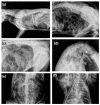Cruelty toward Dogs and Cats in the Republic of Serbia during a 10-Year Period
- PMID: 38998038
- PMCID: PMC11240463
- DOI: 10.3390/ani14131926
Cruelty toward Dogs and Cats in the Republic of Serbia during a 10-Year Period
Abstract
The aim of the study was to point out the importance of recognizing non-accidental injuries (NAI) and to highlight the importance of reporting such cases, as well as prosecuting the perpetrators, in order to detect potentially existing violence or prevent future violence in society. A total of 338 dogs and 54 cats were submitted for necropsy. Out of 338 dogs examined, 175 (51.8%) died due to non-natural cause of death, 122 from natural causes (36.1%), and 35 (10.3%) due to accidental injuries, and in 6 cases (1.8%) the cause and manner of death were undetermined due to advanced post-mortal changes. Out of 54 examined cats, 21 died due to non-natural causes (38.9%) and the same number of cats died due to natural causes. The prevalence of accidental injuries resulting in death were 20.4% (n = 11) and in 1.8% (n = 1) the manner of death remained indeterminate. The high number of animals confirmed to have died from unnatural causes in this study highlights the need for greater involvement from the police, prosecution, and society as a whole to reduce the number of violent animal deaths in the future.
Keywords: abuse; animal; injuries; necropsy.
Conflict of interest statement
The authors declare no conflicts of interest.
Figures





References
-
- Ireland Moore A.N. Defining animals as crime victims. J. Anim. Law. 2005;1:91–108.
Grants and funding
LinkOut - more resources
Full Text Sources
Miscellaneous

